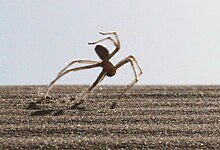Cebrennus rechenbergi
| Cebrennus rechenbergi | |
|---|---|

| |
| Cebrennus rechenbergi in action | |
| Scientific classification | |
| Domain: | Eukaryota |
| Kingdom: | Animalia |
| Phylum: | Arthropoda |
| Subphylum: | Chelicerata |
| Class: | Arachnida |
| Order: | Araneae |
| Infraorder: | Araneomorphae |
| Family: | Sparassidae |
| Genus: | Cebrennus |
| Species: | C. rechenbergi
|
| Binomial name | |
| Cebrennus rechenbergi Peter Jäger, 2014
| |

| |
| Map of Morocco with the Errachidia Province in dark red, the region where Cebrennus rechenbergi lives | |
Cebrennus rechenbergi, also known as the Moroccan flic-flac spider and cartwheeling spider,
Etymology
The spider is named after its discoverer,
Description
Jäger describes C. rechenbergi as a medium-sized huntsman spider. Male bodies measure 13.8 to 19.0 mm (0.54 to 0.75 in) long; female bodies measure 19 to 19.5 mm (0.75 to 0.77 in) long. Males and females are similarly colored white with black scopulae on their ventral legs, and yellow coloring on their dorsal opisthosoma and femora.[5]
Behavior
The Moroccan flic-flac spider is nocturnal and is known to feed on moths before sunrise.
Distribution

C. rechenbergi lives in the sand dunes of the Erg Chebbi desert located in Errachidia Province in southeastern Morocco near the border with Algeria.[5] It is one of 17 species in the genus Cebrennus, typically found in Northern Africa and the Arabian Peninsula.[5][8]
Spider robot
Rechenberg's discovery of the flic-flac spider inspired the development of a biomimetic robot based on the rolling spider locomotion. The design process initially involved at least four generations, with the fourth using six legs in three pairs.[6][Note 1] Rechenberg named the working machine model Tabbot, based on the Berber word "tabacha", meaning spider. The model, which is approximately 25 cm in length, can both walk in the sand and turn somersaults to move.[4] Rechenberg envisions possible uses for the robot "in agriculture, on the ocean floor, or even on Mars".[4][9]
Notes
- ^ When King 2013 published his work on Rechenberg's robot design, Cebrennus rechenbergi had not yet been differentiated from Cebrennus villosus as a new species. King makes a note of this, writing that any future taxonomic changes were beyond the scope of the book.
References
- ISBN 9781783339396.
- ^ a b c Prostak, Sergio (May 6, 2014). "Cebrennus rechenbergi: Cartwheeling Spider Discovered in Morocco". Sci-News.com. Retrieved 23 May 2015.
- ^ a b c d e N. BHANOO, SINDYA (May 4, 2014). "A Desert Spider With Astonishing Moves". The New York Times. Retrieved 23 May 2015.
- ^ a b c d e f g Bröhl, Ilona; Judith Jördens (28 April 2014). "THE MOROCCAN FLIC-FLAC SPIDER: A GYMNAST AMONG THE ARACHNIDS". Senckenberg Gesellschaft für Naturforschung. Retrieved 23 May 2015.
- ^
- ^
- ^ Im Gespräch: Ingo Rechenberg über eine neu entdeckte Art Rollende Spinnen für den Mars. Frankfurter Allgemeine Zeitung, p. 7. January 10, 2009.
- Retrieved 28 July 2014.
- ^ Hays, Brooks (6 May 2014). Robot mimics cartwheel movement of desert spider. United Press International. Retrieved 18 July 2014.
